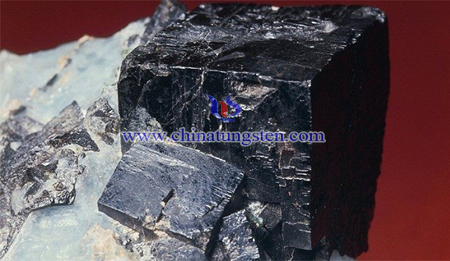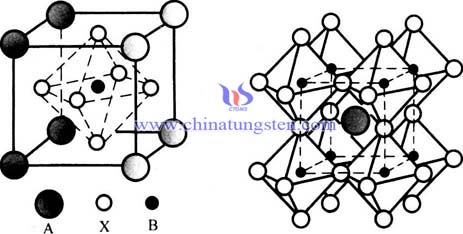TTB Structures Lead-Free Ferroelectrics
- Details
- Category: Tungsten Information
- Published on Monday, 13 June 2016 18:20
Tetragonal tungsten bronze (TTB) structures offer some promise as lead-free ferroelectrics and have an advantage of great flexibility in terms of accessible composition ranges due to the number of crystallographic sites available for chemical substitution. The ferroic properties of interest are coupled with strain, which will be important in the context of stability, switching dynamics and thin film properties. Coupling of strain with the ferroelectric order parameter gives rise to changes in elastic properties, and these have been investigated for a ceramic sample of Ba6GaNb9O30 (BGNO) by resonant ultrasound spectroscopy. Room temperature values of the shear and bulk moduli for BGNO are rather higher than for TTBs with related composition which are orthorhombic at room temperature, consistent with suppression of the ferroelectric transition. Instead, a broad, rounded minimum in the shear modulus measured at ~1 MHz is accompanied by a broad rounded maximum in acoustic loss near 115 K and signifies relaxor freezing behaviour. Elastic softening with falling temperature from room temperature, ahead of the freezing interval, is attributed to the development of dynamical polar nanoregions (PNRs), whilst the nonlinear stiffening below ~115 K is consistent with a spectrum of relaxation times for freezing of the PNR microstructure.
Recently, the tetragonal tungsten bronze (TTB) class of materials—a structure closely related to perovskites, has gathered the attention of the research community. The TTB structure: (A1)2(A2)4(C)4(B1)2(B2)8O30, due to the presence of crystallographically nonequivalent A- and B-sites and an extra C-site, provides supplementary degrees of freedom for manipulation of the structure, huge compositional flexibility allowing the insertion of various metals into the five different TTB sites, nevertheless offering the possibility of fine-tuning both electrical and magnetic behaviour. The TTB structure consists of a network of corner sharing BO6 octahedra formed around the perovskitic A1 site that creates further two types of channels: pentagonal A2 channels (which can be occupied by alkali, alkaline earth and rare earth cations) and smaller triangular C channels (mostly vacant, they can be filled/ just partially filled by small low-charged cations like Li+ —e.g., K6Li4Nb10O30). These materials, known to exhibit diverse properties as a result of compositional flexibility and by a higher probability for cation ordering, may offer better ways of attaining room-temperature ferro-electricity and (anti)ferromagnetism, multiferroic behaviour and eventually magnetoelectric coupling. Whilst ferroelectric TTBs (including Ba2NaNb5 O 15and (Ba,Sr)Nb2O6) were widely investigated during the 1960s and 1970s, our understanding of manipulating this structure type is still poor, with the research surprisingly limited compared to that in perovskites. Early attempts focused on tungsten bronzes of nominal composition A6B10O30(mainly compositions where the C-sites are vacant). A particular interest was developed regarding the Nb-based TTBs due to their enhanced ferroelectric properties over other analogues such as Ta. In the search for novel multiferroic and magnetoelectric materials, the effect of the A-site size in a family of unfilled ferroelectric TTBs Ba4RE0.67Nb10O30(RE = La, Nd, Sm, Gd, Dy, Y) and of the A-site strain on dipole stability in fully filled TTBs family A6GaNb9O30(A = Ba, Sr, Ca) was studied. In addition to their ferroelectric and/or magnetic behaviour, the majority of TTBs reported in the literature exhibit relaxor properties. Most TTBs that have been investigated to date are also lead-free materials.
In recent years, the research dedicated to novel TTB ferroelectric and ferroelectric-related (i.e., relaxors) materials has undergone a revival, with Ba6FeNb9O30(BFNO) as a starting point; many related compositions or solid solutions, usually containing lanthanides, were studied. Arnold and Morrison, and subsequently Liu et al. showed that these compounds display relaxor-type behaviour, with the peak maxima in the dielectric permittivity occurring in the temperature range 130–150 K. Earlier data indicated that BFNO is not electrically homogeneous, with oxygen vacancy gradients due to the variable oxidation state of Fe (Fe3+/Fe2+), as both low-temperature dielectric spectroscopy (DS) and high-temperature impedance spectroscopy (IS) data revealed a higher number of electroactive regions than expected. In order to avoid these additional complications whilst studying such materials, the replacement of Fe3+ with Ga3+ (similar in size) and other trivalent species like Sc3+ and In 3+ was proposed. In previous research, temperature-dependent powder neutron diffraction (TDPND) and microstructural characterisation by scanning electron microscopy (SEM) confirmed the nature of the phases formed and contributed to their crystallographic identification. Moreover, the origin of the polar response and the nature of the relaxor behaviour were established by combining the results of the structural investigations with the dielectric properties inspected by immittance spectroscopy (IS), whilst the dynamics of dielectric relaxation of dipoles was understood by fitting the dielectric data (permittivity and loss) with the Vogel–Fulcher (VF) and the universal dielectric response (UDR) models.


| Tungsten Oxide Supplier: Chinatungsten Online www.tungsten-oxide.com | Tel.: 86 592 5129696; Fax: 86 592 5129797;Email:sales@chinatungsten.com |
| Tungsten News & Prices, 3G Version: http://3g.chinatungsten.com | Molybdenum News & Molybdenum Price: http://news.molybdenum.com.cn |



 sales@chinatungsten.com
sales@chinatungsten.com